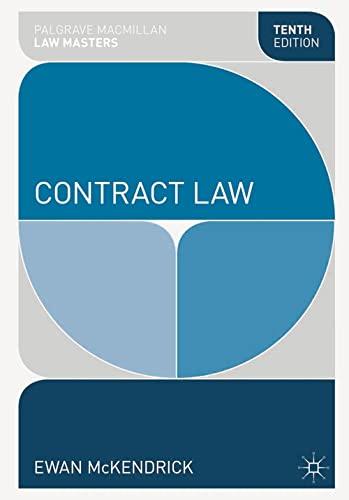Question
In the mid-1980s, plaintiff representatives of a purported class each purchased a life insurance policy from defendantGuardian Life Insurance Company of America. Each policy was
In the mid-1980s, plaintiff representatives of a purported class each purchased a life insurance policy from defendantGuardian Life Insurance Company of America. Each policy was a "Whole Life Policy With Specified Premium Period." The policies contained provisions setting forth the periods for which premiums were to be paid. These periods varied from policy to policy and ranged from 10 years to life. Plaintiffs allege that they bought their policies on the strength of false representations made to them by a Guardian sales agent. They assert that as part of the company's standard marketing presentation, the agent prepared a personalized "vanishing premium" illustration for each plaintiff. Using this device, the agent allegedly represented to each plaintiff that he or she would have to pay annual premiums out-of-pocket for only the first eight years of the policy, assuring each of them that the policy's dividends would thereafter cover the premium costs. Plaintiffs contend that the illustrations were premised on dividend projections that Guardian knew or should have known were untenable. Specifically, they allege that Guardian, in the mid-1980s, artificially inflated its current dividend rates despite waning profits because it wanted to continue depicting competitive vanishing dates. On a separate page, accompanying each illustration, however, limitations such as the following appeared:
"Figures depending on dividends are neither estimated nor guaranteed, but are based on the [current year's] dividend scale." "The [current year's] dividend scale reflects current company claims, expense, and investment experience * * * and taxes under current laws. Actual future dividends may be higher or lower than those illustrated depending on the company's actual future experience." After deciding to purchase the policy each plaintiff signed an application. Several weeks later Guardian delivered the policies. Each policy contained the following provisions:
(1) "[a] participating policy shares in Guardian's divisiblesurplus. The policy's share, if any, is determined yearly by Guardian"; and
(2) "[t]he dividend will reflect Guardian's mortality, expense, and investment experience."
Moreover, the policies contained several integration or merger clauses stating, in words or substance, that only the actual policy provisions controlled. In 1995, eight years after the sale of the policies, Guardian informed each plaintiff that his or her premiums would, in fact, not vanish and that if the policies were to remain in force, plaintiffs would have to continue out-of-pocket premium payments. Plaintiffs brought this purported class action suit against Guardian in 1996. In its pre-answer motion, Guardian moved to dismiss. Supreme Court granted the motion and dismissed the complaint for reasons that varied with the particular plaintiff.[5]The Appellate Division affirmed but made no distinction among plaintiffs, holding that, among others, the fraudulent inducement and General Business Law 349 claims failed as a matter of law (Gaidon v Guardian Life Ins. Co.,255 AD2d 101, 101-102).
1.Business intelligence equips enterprises to gain business advantage from data
2.BI is a category of database software that provides an interface to help users quickly and interactively scrutinize the results in a variety of dimensions of the data
3._________ is a category of applications and technologies for presenting and analyzing corporate and external data.
4.________ is a performance management tool that recapitulates an organization's performance from several standpoints on a single page.
5.BI can catalyze a business's success in terms of?
6.If a nurse finds that a patient's abdominal wound has eviscerated, she should?
7.A patient with a history of heart disease can be put on a prophylactic antibiotic.
8.In diseases that have night sweats as a symptom (e.g. tuberculosis,
infective endocarditis), what causes the sweats to occur only at night and
not consistently during the day as well?
9.What dosage of steroids and duration of treatment should be given to
patients with idiopathic pulmonary fibrosis? What are the new drugs,
their recommended dosage and duration of treatment?
(a tumor necrosis factor- receptor blocker), and imatinib [a platelet-derived growth factor (PDGF) inhibitor].
10.Business intelligence (BI) is a broad category of application programs which includes
Step by Step Solution
There are 3 Steps involved in it
Step: 1

Get Instant Access to Expert-Tailored Solutions
See step-by-step solutions with expert insights and AI powered tools for academic success
Step: 2

Step: 3

Ace Your Homework with AI
Get the answers you need in no time with our AI-driven, step-by-step assistance
Get Started


